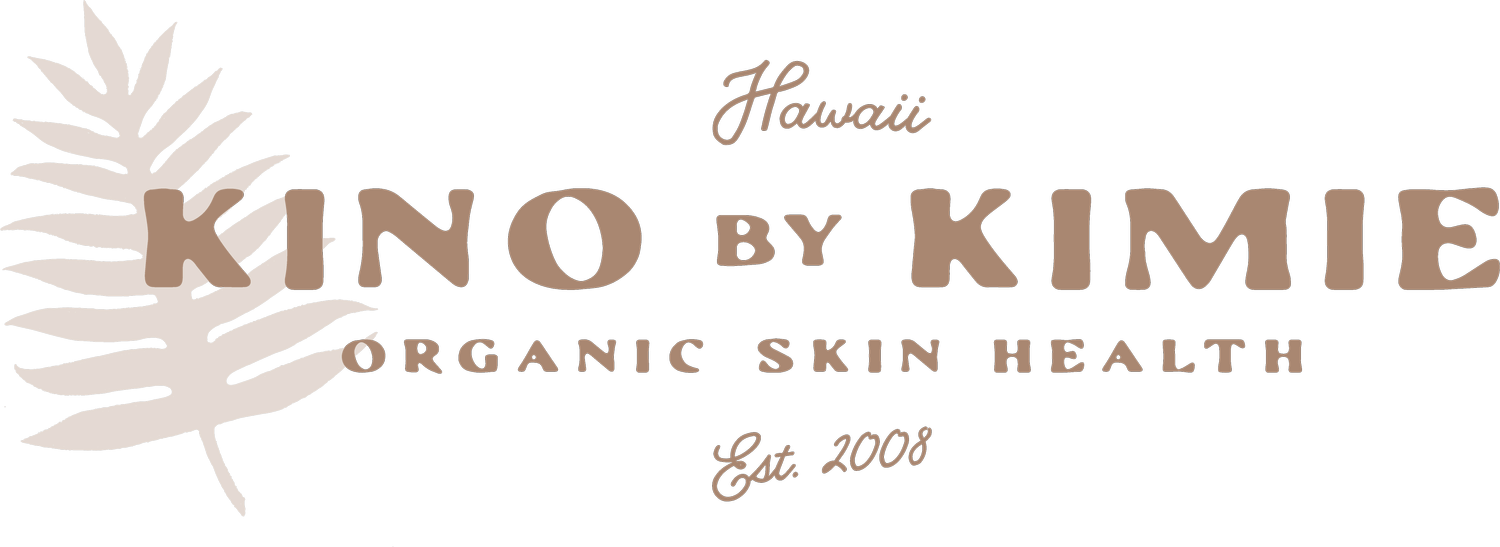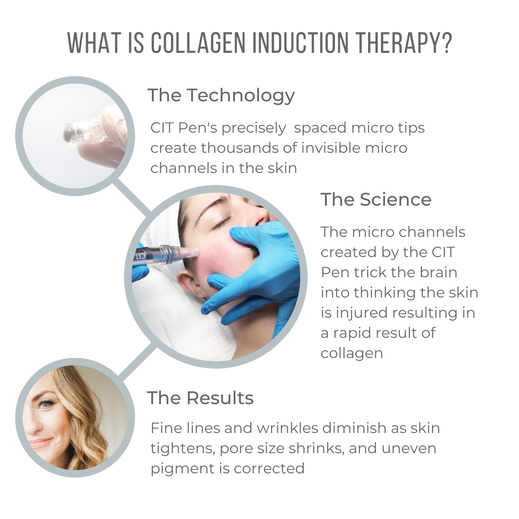
Collagen Induction Therapy
(Microneedling) FAQs
-
-Scarring- surgical, thermal, and acne (scars must be at least 6 months old)
-Stretch marks
-Cellulite
-Enlarged pores
-Dyspigmentation (due to sun damage and/ or hormonal imbalances e.g. Melasma)
-Fine lines and wrinkles
-Loose skin
-Dehydrated skin
-
A licensed skin care professional glides the CIT pen over professional strength serums or sterile saline in a cross link or circular pattern over the skin to puncture the epidermal layers of the skin and create microscopic subcutaneous injuries. These microscopic channels in the skin allow for optimal product absorption. The microscopic injuries created with the CIT Pen stimulate a repair response & new collagen production with minimal to no downtime.
-
As the CIT pen creates micro-channels into the skin, pores are temporarily opened allowing the enhancement serum to be fully penetrated. Micro-point punctures in the skin are created. This is a controlled injury to the skin and is perceived by the body as damage. This stimulates the release of growth factors that trigger the production of Collagen and Elastin. Skin reacts to this CIT treatment by initiating the healing process which encourages your skin to continue to regenerate.
-
With the automated CIT Pen micro-needling treatments, the skin is tricked into repairing itself. The process of micro-needling skin remodeling can continue to enhance for months after treatment as the skin continues to repair itself. Results can be seen within a few days to a week. Skin naturally heals itself every 45 days so by simply adding micro-needling stimulation the changes can be accelerated and your skin will see results. Depending on your expectations and personal goals we recommend a series of CIT Pen sessions to speed up the process and achieve optimum results. However; skin improvement is noticeable after just one treatment! Immediately following treatment, your skin will have some redness and flushed in appearance like a moderate sunburn. You will also experience skin tightness and mild sensitivity to the treated area as well as some peeling depending on the depth. 24 hours and up to 36 hours there is little to no evidence of injury to the treated area, however tightness and peeling can occur.
-
Skin needling can be safely performed on all skin colors and types. There is no risk of post-inflammatory hyper-pigmentation as the melanocytes remain intact (as long as post-care instructions are followed). Other invasive procedures such as laser resurfacing are not recommended for Asian or African American skin due to the potential risks of delayed wound healing, pigment changes, and scarring. However, with Collagen Induction Therapy/ Micro-needling, the potential risks on ethnic skin are unlikely due to the epidermis remaining intact.
-
Mild Rosacea, can be improved. When the Spinosum layer is strengthened through CIT, the collagen stimulated will support the dermal papillae, which will reduce the appearance of broken capillaries.
-
The number of CIT treatments depends on your current skin condition and goals. Three to four treatments may be needed for moderate acne scars. Scars from thermal burns and stretch marks may require between 6-10 CIT sessions. The added Collagen lasts up to 12 months and a refresher treatment is recommended every 6 months to 1 year in order to fight the signs of aging. Multiple package sessions may be needed to reach your desired results in order to meet your realistic expectations.
-
The variety of needle cartridges along with the CIT Pen’s ability to gauge the needle depth allows this treatment to be customized to fit each of your clients’ needs and comfort levels. Application of local anesthetic numbing cream can prevent treatment discomfort.
-
Results are seen at the cosmetic depth of 0.25mm. Cosmetic micro-needling is considered to work only in the granular & mid spinosum layers. Working on a cosmetic depth (0.3mm and below) releases growth factors by stimulating Keratinocyte cells.
Clinical studies have shown that regardless of the depth of injury to the skin, new collagen forms no deeper than 0.6mm. Working above 0.5mm is considered a medical treatment. Micro-Needling at “medical depths” has shown to be dramatically effective for scar removal, cellulite reduction, stretch marks, hyper-pigmentation and reduction of fine lines and wrinkles. How can PRP benefit CIT? Platelets contain multiple growth factors that stimulate tissue growth. Collagen is the main component of connective tissue.
-
This treatment typically recovers at a rapid rate & redness subsides within 24 hours. Negative side effects should not take place if you are following proper protocol. Professionals should never treat a client with any listed contraindications (see below). Swelling during the recovery phase can occur, skin infection with bacteria (rare) or herpes simplex virus (cold sores), Milia, which can be easily removed and mild acne flare ups may occur after the treatment. If any of these symptoms persist and/or worsen please seek immediate medical attention. As the microscopic channels to the skin close quickly, post-operative wound infection is extremely rare. Emollients and/ or topical antibiotics may be prescribed, if considered necessary.
-
● Keloid or raised scarring.
● History of Eczema, Psoriasis and other chronic conditions.
● History of Herpes Simplex infections.
● Uncontrolled Diabetes (Controlled must have a doctor's consent to move forward)
● Raised moles, warts or raised lesions in targeted area.
● Patients must be off blood thinners for 3-5 days pre-micro needling
● If on any medications or drugs prescribed by a doctor need to be cleared prior to session
● Pregnancy (Approach with caution)
Absolute contraindications include:
SMOKING OR CHEWING OF ANY SORT (tobacco, nicotine, cigars, hookah, vaping, medical marijuana etc)
● Scleroderma (hardening of the skin).
● Collagen vascular diseases or cardiac abnormalities.
● Blood clotting problems.
● Active bacterial or fungal infection.
● Immune-suppression diseases.
● Scars less than 6 months old.
● Facial fillers in the past 10 days.
● Warts
● Accutane
● Eczema
● Photosensitivity
● Severe allergies
● Liver disease
● Hepatitis
Possible side effects:
● Redness
● Burning/ Stinging
● Dryness
● Flaking
● Track Marks
● Breakouts
● Swelling
● Rash
● Bruising (rare)
● Cold sores (rare)
● PIH (rare)
-
In order to avoid post inflammatory hyperpigmentation post treatment one must recognize the drugs and supplements that cause photosensitivity. Please be advised that although these medications are not absolute contraindications they may make your skin sensitive to the sun. Proceed with caution, extra sun protection or eliminate from your routine if possible.
❏ Antibiotics – Sulpha, Tetracycline, Zithromax, Quinolones
❏ Antidepressants- Zoloft, Effexor, Elavil, Remeron
❏ Antihistamines- Benadryl, Claritin, Hismanal, Atarax, Phenergan, Seldane
❏ Diuretics
❏ Anti-cholesterol agents
❏ Nsaids
❏ Accutaine
❏ Tretinoin
❏ Gabapentin
❏ Benzyl Peroxide
❏ St. Johns Wort
❏ Dong Quai
-
1. Avoid direct sun exposure or tanning bed at least 4 weeks prior to treatment and during treatment process.
2. Do not exercise the day of or for 48 hours after the induction treatment.
3. Avoid caffeine containing food or beverages day of treatment.
4. Avoid medications such as: Aleve, Advil, cold remedies, Vitamin E or aspirin 5 days prior to treatment.
5. Avoid Retin-A, chemical peels, injectable fillers or Botox 2 weeks prior to treatment.
6. Discontinue Hydroquinone, AHA’s, BHA’s, Benzoyl peroxide, and any other possible irritants 3-5 days prior to treatment.
7. Use agreed upon gentle cleanser. Double cleanse to make sure skin has been properly cleansed of all debris and oils. No Makeup or topicals should be left on the skin.
8. Apply topical anesthetic cream 1 hour prior to procedure and reapply if necessary.
9.Day of treatment wear comfortable clothing. Your top should button or zip rather than pull over the head.
10. Notify medical Aesthetician if you get cold sores. You will require an antiviral prescription to avoid any breakout after treatments.
11. If you have open cuts, wounds, abrasions or during active acne or cold sores breakouts, we cannot perform the procedure.
12. Stay hydrated all the way up to your appointment. Dehydrated skin will not show erythema because the blood is contracted. The skin will not heal as quickly if your are not hydrated properly. A good rule of thumb is half your body weight in ounces every day.
-
1. Gently massage the face with lukewarm water and use your fingers only to remove serum and other debris such as dried blood. Do not scrub, use a wash cloth or a Clarisonic brush. Starting from day 2 you may cleanse the area treated twice a day with a gentle cleanser or oil cleansing method. Do not use exfoliating products for 72 hours.
2. Keep skin hydrated with the Vitamin C CIT Enhancement serum and a hydrating toner throughout the day.
3. Cold compresses may be applied following treatment for comfort. If neck or décolletage are treated, the redness might last slightly longer.
4. Do not exercise for 24 hours after treatment.
5. Avoid direct sun light, saunas, steam rooms, hot baths or showers until redness is gone.
6. Continue to avoid sun exposure to the treatment areas and apply a broad spectrum sunblock with SPF minimum of 30. Apply it at least 30 minutes prior to sun exposure and repeat after every two hours of sun exposure.
7. After 2-5 days patients can return to regular skin care products or as soon as it is comfortable to do so. Mineral makeup may be applied the following day.
8. Avoid strenuous exercise for two to three days after treatment.
9. Avoid waxing, facials, Botox, injectable fillers or any other skin care treatment 10 days – two weeks after treatment.
10. New cell regeneration requires at least 6-8 8 oz. glasses of water a day (if you already drink that- increase by 2 glasses)
11. If skin becomes painful, swollen, red or inflamed, please notify your skin care professional, as this may represent an infection or allergic reaction that may require treatment.

